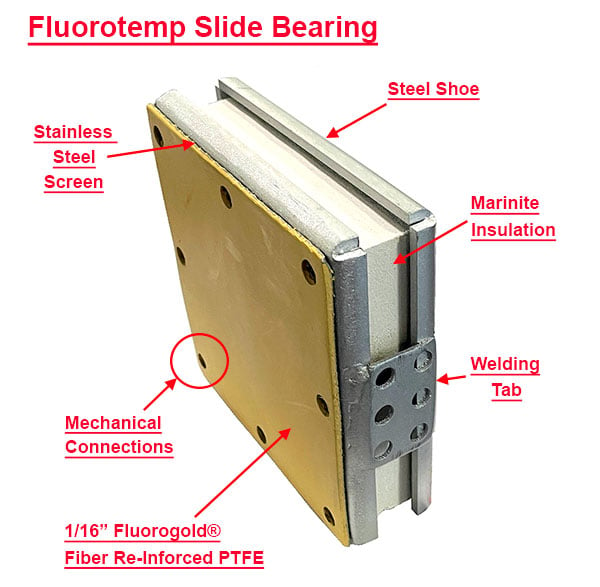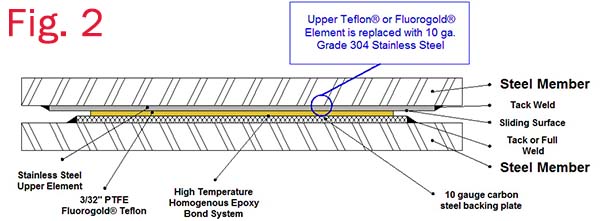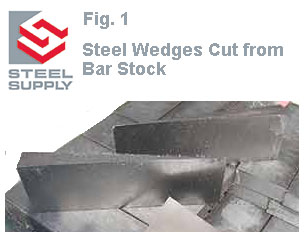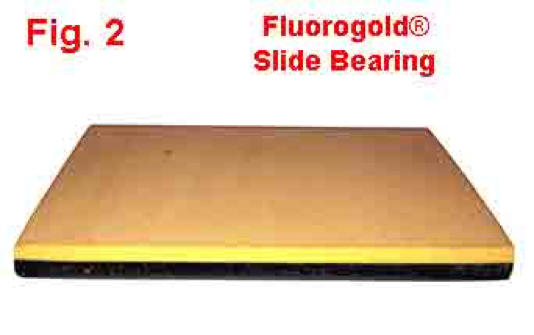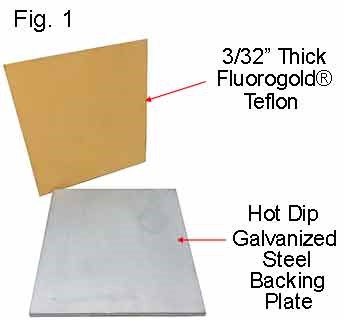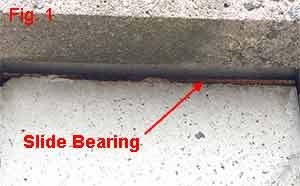In Slide Bearing design as the anticipated operating temperature increases adjustments have to be made to the bearing configuration. At approximately 400°F / 204°C the glue that bonds the Fluorogold® or Teflon® to the backing plate will melt and failure will occur soon afterward.
Steel Manufacturing Blog: Keeping it Steel
They will be found on plans for everything from offshore drilling platforms, big box stores, renovations, or any structure where the stress of movement, expansion and contraction needs to be relieved.
Slide Bearing Designs and Specifications: How to Overcome Higher Temperatures and Higher Pressures
Slide Bearing design and specifications fall into categories with the most common being FC-1010-CS, a 3/32” layer of Fluorogold® bonded to 1/8” thick carbon steel. An upper and lower member of FC-1010-CS are used to create the slide bearing, as shown in Fig. 1. This is the most common configuration and can function effectively in the following ranges:
Tags: Slide Bearing, Slide Bearings, Teflon Slide Bearing, Fluorogold Slide Bearing
When manufacturing made to order steel wedges there are a number of ways it can be done and usually the configuration dictates what method is selected. Some of these are outlined in a previous blog, Steel Wedge Manufacturing. The Steel Wedge we are focusing on in this conversation is required as part of a Fluorogold® or Teflon® Slide Bearing Assembly. Length is 20", Width is 14". Thickness starts at 1/2" and tapers down to 1/16". The unique size of this wedge dictates the manufacturing process.
Tags: Wedges, Steel Wedge, Slide Bearings, Steel Wedges Made To Order
In many of the requests we receive for Fluorogold® or Teflon® Slide Bearing Assemblies the fabricator is under the impression the specific dimensions they require will cut to size, then bonded together and finished. This can be done, but only starts to make economic sense when the requirements call for a large quantity of the same dimensions.
When designing a Teflon® or Fluorogold® Slide Bearing, one of the factors that sometimes gets overlooked is the maximum operating temperature the bearing assembly will function at. Standard Structural Steel expansion type joints don’t develop the heat required for temperature to be a concern, but many specialized applications do. Steam Lines, Furnaces, Ovens, etc. all present environments that can compromise a standard FC-1010-CS slide bearing.
Tags: Slide Bearings, Bearings
Teflon® or Fluorogold® Slide Bearings are engineered to wear out. Like any sacrificial structural component, the idea is to protect the more critical, expensive or impossible to replace members. By design, the Teflon® surface should be where all the wear occurs. Ideally, the steel backing plate should never be the part that causes the bearing to be replaced.
Tags: Slide Bearings
Initial installation of a Slide Bearing Assembly can be very different from the eventual replacement of the very same bearing. Virtually, all bearing assemblies are intended to be replaced at some point during the life of the structure. This is true of Teflon® Slide Bearings and the more durable Fluorogold® Slide Bearings. It also holds true for Elastomeric Bearings, Viblon Shims and Bearings, and Commercial Grade Neoprene. In our experience, we have not seen an application where a bearing assembly was intended to be permanent.
Tags: Slide Bearings, Bearings
The typical Slide Bearing design used in Steel Fabricating, whether Teflon®, Virgin PTFE or Fluorogold®, is 7/32” thick. This is comprised of a 1/8” thick steel backing plate and 3/32” Teflon® bonded to it. Most often, they are in pairs with the Teflon® surfaces in the middle as shown in the illustration.
Tags: Slide Bearings





